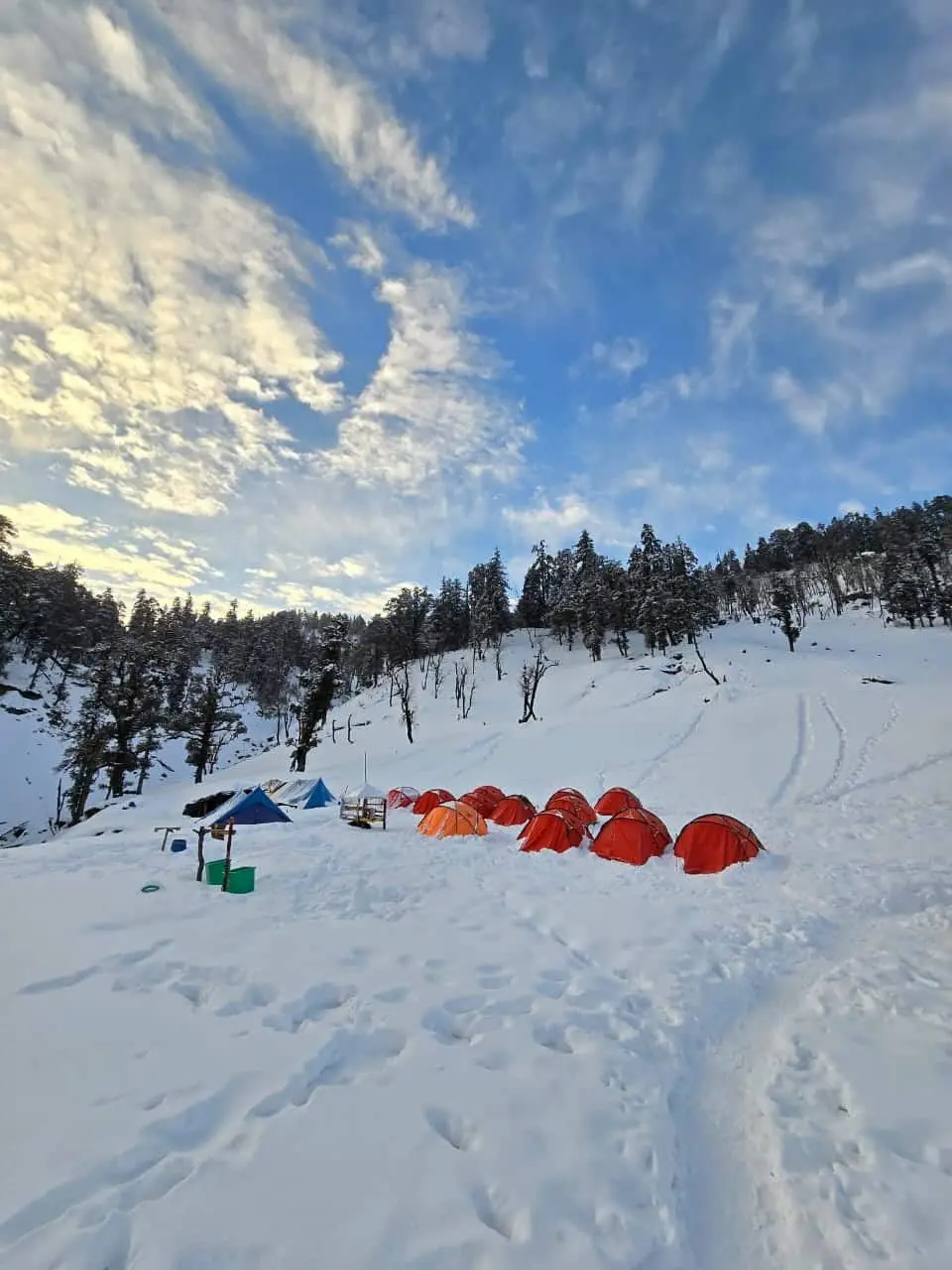
Each legend provides its own account of Kedarkantha and Juda-ka-Talab lake located along a trek route leading towards Uttarkashi District in Uttarakhand.
These tales revolve around Lord Shiva's activities during his stay at Kedarkantha.
Kedarkantha Trek, a five-day journey starting from Sankri, 200 kilometers south of Dehradun at 6,500 feet, winds its way through beautiful oak and pine forest as part of the Govind Wildlife Sanctuary, set against snow-covered mountain peaks. Your overnight stop should be near Juda-ka-Talab; an idyllic meadow situated at 9000 feet; thereafter trekkers head onward to Kedarkantha's base camp which rises up to an incredible 12,500 feet!
At the summit, there is a temple dedicated to Lord Shiva which is made out of stones and situated next to a snow-capped mountain. A Trishul is standing statue at its foundation that attracts pilgrims who visit this shrine in thanks for guiding their lives. Furthermore, an underground small temple houses an idol of Lord Ganesha during hot and dry summers in an effort to bring rain.
Legend holds that Lord Shiva selected Kedarkantha Mountain's summit for deep meditation, but was disturbed by a bull charging across the valley below. To find peace again, Lord Shiva relocated nearby Kedarnath town in Uttarakhand where he resumed his practice of deep contemplation.
Local legends speak of the Pandavas traveling towards the Himalayas to seek divine blessings from Lord Shiva. In order to avoid being discovered by Bheem, Shiva transformed himself into the form of a bull; but even this disguise failed; Bheem chased after Shiva anyway and chased after his body parts until finally coming out into view where they scattered throughout different locations; his neck eventually landing at Kedarkantha peak and thus becoming known as his "throat."
This myth shares similarities with the legend of Panch Kedar - five Shiva temples located in Uttarakhand's Garhwal region which include Kedarnath, Tungnath, Rudranath Madhyamaheshwar and Kalpeshwar - located there. According to legend, when advised by Lord Krishna to ask Shiva for forgiveness for killing their loved ones during Mahabharata wars they asked for mercy; however Shiva turned into a bull instead and sent the Pandavas back home before leaving for Garhwal area.
Guptakashi attempted to capture Lord Shiva as an animal-shaped bull at Guptakashi's mountains; the Pandavas witnessed his appearance as a lion instead, only for it to fly off into space instead of appearing again as Lord Shiva at five different locations such as Kedarnath (with legs at Tungnath and Rudranath for faces and Rudranath for stomach). They believe the Pandavas built temples at each location.
As trekkers climb towards Kedarkantha summit, they will enjoy a magnificent panoramic view of the Swargarohini mountains which rise over 10,000 feet and comprise four distinct mountain peaks. According to local mythology, Swargarohini was used by Yudhishthira, one of the Pandavas, on their journey into heaven; unfortunately however, only Yudhishthira reached heaven, leaving behind all others in his wake.
Kalanag Mountain is one of the region's most prominent landmarks and often referred to as "Black Peak". The name for the mountain comes from its likeness to an inky cobra's head.
Bandarpoonch Mountain stands near Black Peak. The name itself translates to "monkey's tail", and may have its origin in Hanuman - revered as God of Monkeys or Monkey God in Hinduism.
Story behind juda ka talab
Juda Lake, located on Kedarkantha's first campsite immediately following Sankri, was said to have been formed when Lord Shiva sought an area in which to shed his hair by casting away a knotted mass into the earth resulting in its creation as this lake.
According to local legend, two bodies of water met and ultimately joined together into one vast body that we now see today.

One story recounts, wherein one shepherd was watching over his flock by the lake while playing his flute on a tiny hill in the middle of it and it fell off, landing at the bottom. After searching unsuccessfully, he gave up and headed back into town along with the goats; upon reaching there, he found it sitting on a woman's table as she collected streams nearby! In response to his inquiries she revealed it as her discovery!
According to some, multiple streams flowing from lakes into nearby rivers create what is referred to as "juda," or a link between lakes and rivers.
